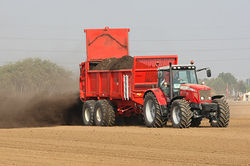Difference between revisions of "Nitrates Directive"
From Coastal Wiki
Dronkers J (talk | contribs) |
|||
| (68 intermediate revisions by 2 users not shown) | |||
| Line 1: | Line 1: | ||
| − | + | <P ALIGN="justify"> The 1991 '''Nitrates Directive''' (91/676/EC) is one of the earliest pieces of EU legislation aimed at controlling pollution and improving water quality and forms integral part of the [[Water Framework Directive|Water Framework Directive]].</P> | |
| − | |||
| − | == | + | == Main objectives == |
| + | <P ALIGN="justify"> | ||
| + | The Nitrate Directive aims '''to protect water quality''' across Europe by '''preventing nitrates''' from agricultural sources '''polluting ground and surface waters''' (nitrate is perhaps the most widespread groundwater contaminant and originates from natural sources, organic sources, atmospheric deposition, and inorganic [[fertilizer]]) and by '''promoting the use of good farming practices. | ||
| + | '''</P> | ||
| − | + | == Implementations== | |
| − | [[ | + | [[Image:Manurefertilizer.jpeg|right|thumb|250px|<small>Use of fertilizers in agriculture (Photo credit: Werktuigendagen)</small>]] |
| + | *'''Identification of surface waters and groundwater affected by pollution''' (or at risk) based on criteria described by the Directive (specifically when the concentration of nitrates in groundwater or surface water (especially those intended for drinking water) reaches more than 50 mg/l or when the surface water found to be [[eutrophic]] (or could become eutrophic) | ||
| + | *Designation of '''Nitrate Vulnerable Zones''' (Areas of land that become polluted by nitrates - in Europe they are identified as vulnerable when they exceed or being at risk of exceeding 50 mg/l of nitrates) | ||
| + | *Establishment of a code of '''Good Agricultural Practice to be implemented by farmers on a voluntary basis''' to prevent nitrate losses to water by leaching and run-off [http://eur-lex.europa.eu/LexUriServ/LexUriServ.do?uri=CELEX:31991L0676:EN:PDF (see Annex 2)] | ||
| + | *Setting up compulsory '''action programmes''' to be implemented by farmers who work in Nitrate Vulnerable Zones (NVZs) based on measures listed in the Good Agricultural Codes [http://eur-lex.europa.eu/LexUriServ/LexUriServ.do?uri=CELEX:31991L0676:EN:PDF (see Annex 2)] and those concerning the limitation of fertilizer application[http://eur-lex.europa.eu/LexUriServ/LexUriServ.do?uri=CELEX:31991L0676:EN:PDF (see Annex 3)]. | ||
| + | *Every '''four years''' member states must '''report''' on nitrate concentrations (groundwater and surface water), NVZs, eutrophication in surface waters and action programme(s) (revision and assessment of the impact on water quality and agricultural practices). | ||
| − | + | == References == | |
| + | Text of The Nitrates Directive [http://eur-lex.europa.eu/LexUriServ/LexUriServ.do?uri=CELEX:31991L0676:EN:PDF] | ||
| − | == | + | == External links== |
| − | + | [http://ec.europa.eu/environment/water/water-nitrates/index_en.html The European Commission, The Nitrates Directive] | |
| − | |||
| − | |||
| − | |||
| − | |||
| − | |||
| − | |||
| − | |||
| − | = | + | {{author |
| − | + | |AuthorID=26102 | |
| − | + | |AuthorFullName= Knockaert, Carolien | |
| − | + | |AuthorName=Carolienk}} | |
| − | |||
| − | |||
| − | |||
| − | |||
| − | |||
| − | |||
| − | |||
| − | |||
| − | |||
| − | |||
| − | |||
| − | |||
| − | |||
| − | + | [[Category:Eutrophication]] | |
| − | + | [[Category:Legislation and conventions]] | |
Latest revision as of 09:23, 8 August 2019
The 1991 Nitrates Directive (91/676/EC) is one of the earliest pieces of EU legislation aimed at controlling pollution and improving water quality and forms integral part of the Water Framework Directive.
Main objectives
The Nitrate Directive aims to protect water quality across Europe by preventing nitrates from agricultural sources polluting ground and surface waters (nitrate is perhaps the most widespread groundwater contaminant and originates from natural sources, organic sources, atmospheric deposition, and inorganic fertilizer) and by promoting the use of good farming practices.
Implementations
- Identification of surface waters and groundwater affected by pollution (or at risk) based on criteria described by the Directive (specifically when the concentration of nitrates in groundwater or surface water (especially those intended for drinking water) reaches more than 50 mg/l or when the surface water found to be eutrophic (or could become eutrophic)
- Designation of Nitrate Vulnerable Zones (Areas of land that become polluted by nitrates - in Europe they are identified as vulnerable when they exceed or being at risk of exceeding 50 mg/l of nitrates)
- Establishment of a code of Good Agricultural Practice to be implemented by farmers on a voluntary basis to prevent nitrate losses to water by leaching and run-off (see Annex 2)
- Setting up compulsory action programmes to be implemented by farmers who work in Nitrate Vulnerable Zones (NVZs) based on measures listed in the Good Agricultural Codes (see Annex 2) and those concerning the limitation of fertilizer application(see Annex 3).
- Every four years member states must report on nitrate concentrations (groundwater and surface water), NVZs, eutrophication in surface waters and action programme(s) (revision and assessment of the impact on water quality and agricultural practices).
References
Text of The Nitrates Directive [1]
External links
The European Commission, The Nitrates Directive
Please note that others may also have edited the contents of this article.
|
